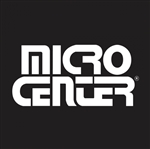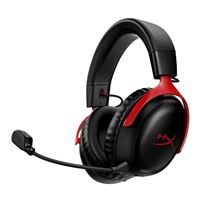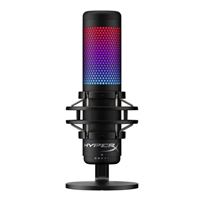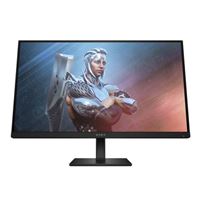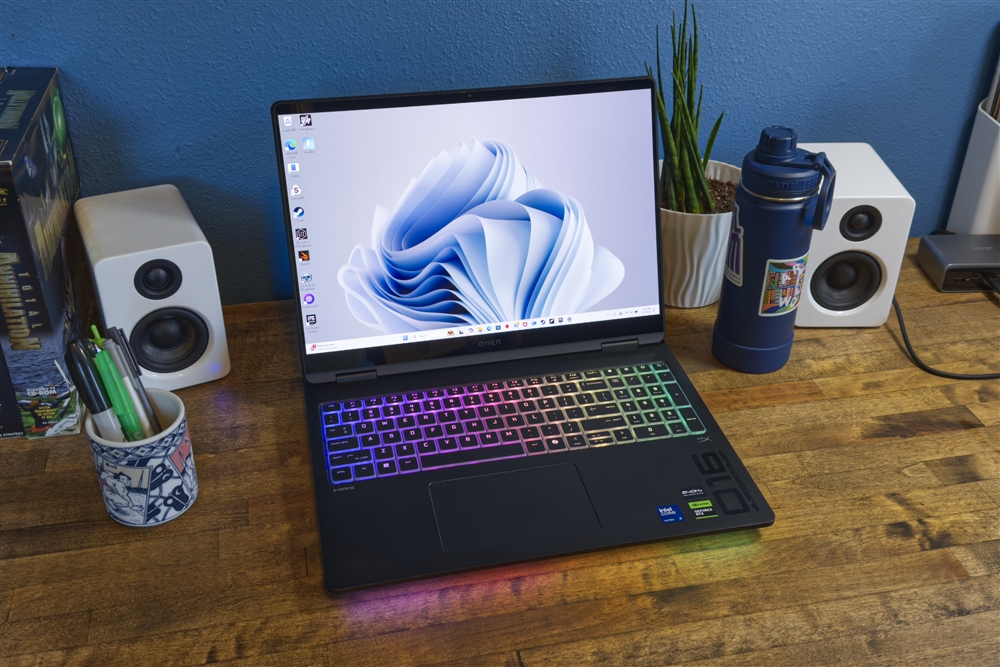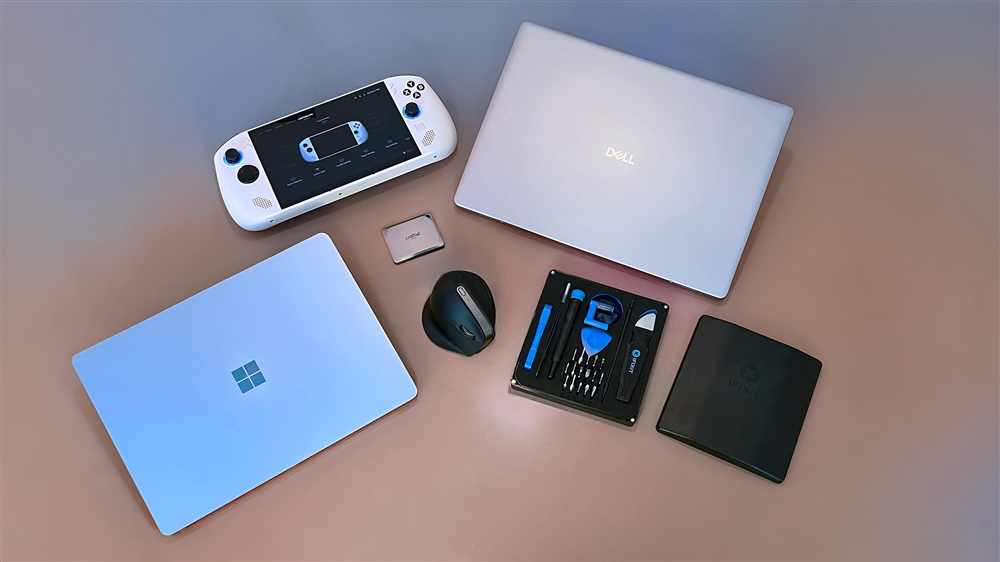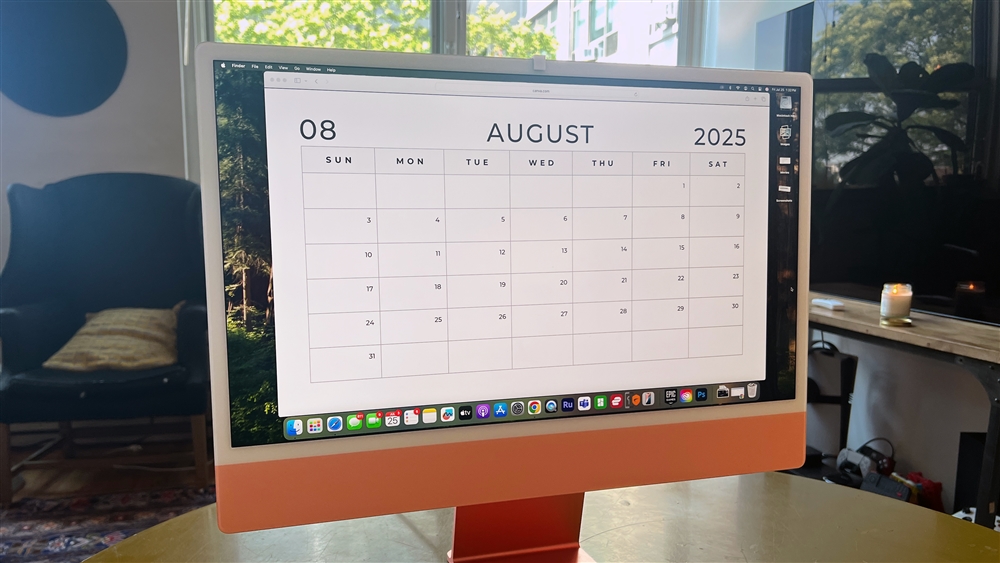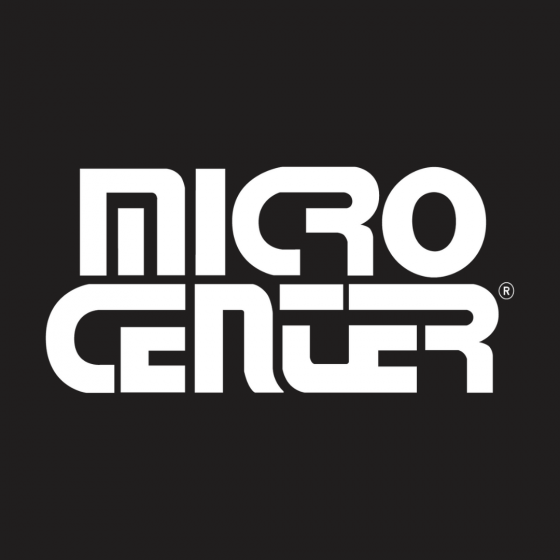Hands On with the HP Omen Max 16
In a sea of similar gaming laptops, HP’s latest stands out by delivering on performance and price.Reviews
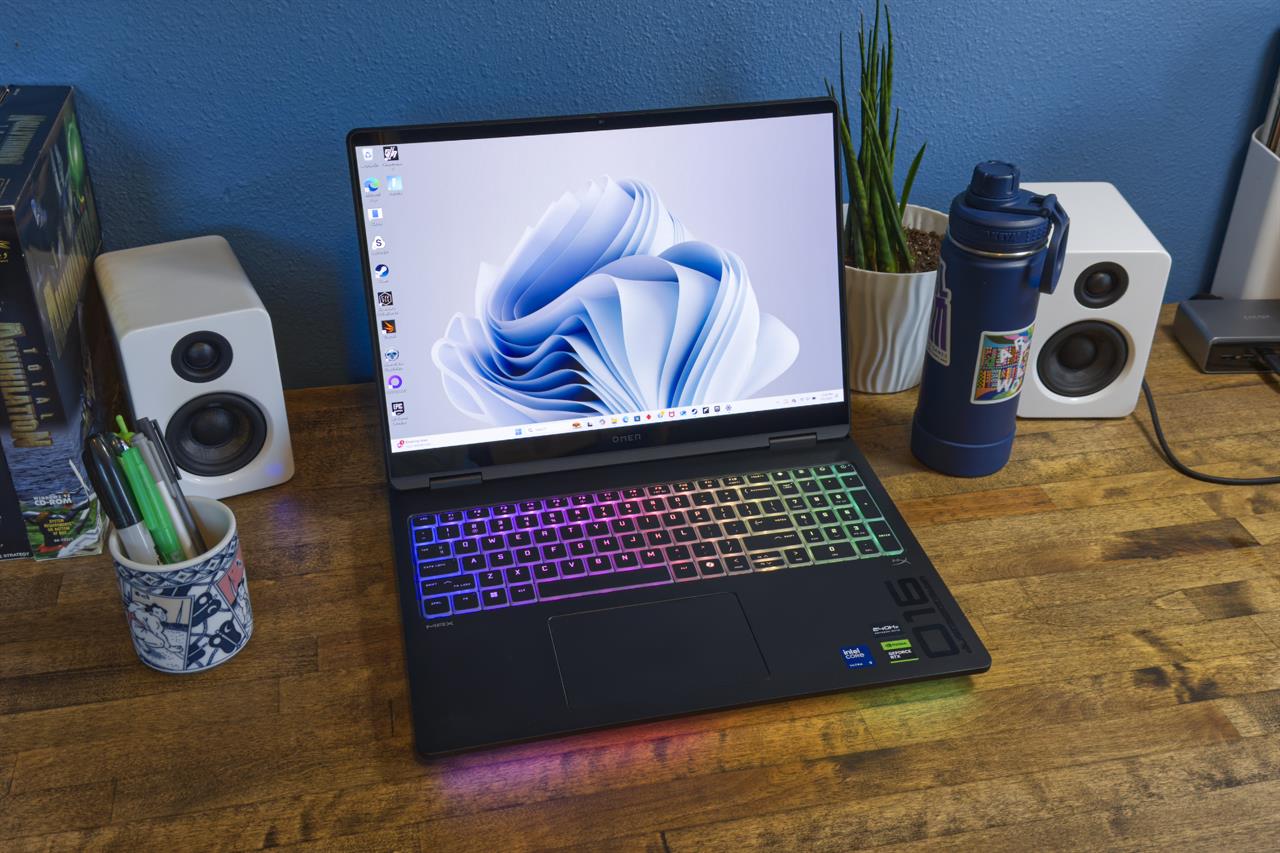
The initial trickle of new Nvidia RTX laptops is now a flood, with multiple laptops and configurations available. More choice is great, of course, but it leads to a problem every PC gamer who has ever shopped for a laptop is familiar with: deciding between numerous options built on very similar hardware.
The HP Omen Max 16 isn't especially flashy or thin, but it delivers strong 50-series GPU performance at an attractive price, and that's enough to help it stand out from the crowd and make it worth a long look.
Performance
The HP Omen Max 16’s specifications are similar to many high-end gaming laptops with Nvidia RTX 50-series hardware. It packs an Intel Core Ultra 9 275HX processor and Nvidia RTX 5080 graphics, a capable one-two punch that delivers plenty of CPU and GPU power. Importantly, the RTX 5080 has access to up to the full 175 watts of graphics power, which is the most it’s designed to handle.
The CPU and GPU are flanked by a healthy 32GB of DDR5-5600 RAM and a single 2TB PCIe Gen4 NVMe solid state drive. I particularly like the large SSD. Today, with many games exceeding 100GB and a few pushing into 200GB or more, a 2TB drive is starting to feel like the new standard. This configuration is currently $2,499.
Still, game performance is what really matters. The Omen Max 16 seems to have the goods on paper, but does that translate to great performance in real games.
HP Omen Max 16 Benchmark Scores
| Test/Game | Settings | Result |
|---|---|---|
| 3DMark | Speed Way | 5,748 |
| Port Royal | 14,147 | |
| Time Spy | 20,948 | |
| Cyberpunk 2077 | 1600p Overdrive, No DLSS | 23 FPS |
| 1600p Overdrive, DLSS Transformer (2x Frame Gen) | 77 FPS | |
| 1600p Overdrive, DLSS Transformer (4x Frame Gen) | 141 FPS | |
| Sid Meier’s Civilization VII | 1600p High MSAA | 153 FPS |
| Fortnite | 1600p Epic Ray-traced, FXAA | 55 FPS |
| 1600p Epic Ray-traced, DLSS Quality | 82 FPS | |
| Ghostrunner 2 | 1600p Epic/High | 152 FPS |
| 1600p Epic/High, DLSS (No Frame Gen) | 187 FPS | |
| Ashes of the Singularity: Escalation | 1600p Crazy | 116 FPS |
Put simply? Yes. The HP Omen Max 16 is a performer.
Larger, more expensive alternatives like the MSI Raider 18 HX AI will deliver higher framerates. The same can be said, of course, for RTX 5090 laptops like the Asus ROG Strix Scar 18 G835LX or the Alienware 18 Area-51.
Still, the Omen Max 16 comes close to more expensive competitors. Shockingly close. It’s just a few hundred points behind those larger competitors in 3DMark’s ray-traced Port Royal and Speedway benchmarks, for instance.
Real-world game performance is strong, too. Many games can exceed 120 frames per second at the Omen Max 16’s native resolution of 2,560 x 1,600. Cyberpunk 2077’s notoriously demanding ray-traced Overdrive preset is a challenge but, with the help of DLSS Frame Gen, the Omen Max 16 can provide a 60 FPS gameplay experience (or 120 FPS with Frame Gen 4x). I’d recommend playing at a lower ray-traced setting for a smoother experience, but if you want to see the game in all its ray-traced glory, it’s playable.
But you'll want to make sure you stay plugged in while gaming. The Omen Max 16 has an 83-watt-hour battery. That’s not bad, but many powerful laptops pack a 90-watt-hour battery, or larger. In my testing, the laptop could handle about four to six hours of modest use (browsing the web, using Microsoft Office apps, and watching YouTube). Games can drain the battery in an hour or two, though that’s true of most gaming laptops.
These aren't unexpected battery life numbers for a modern gaming laptop that has a high-end CPU and GPU. And while it has its limits, the battery still lasts long enough to handle a couple college classes, a short flight, or a trip to your local coffee shop.
Design and features
Compared to some other recent gaming laptops, the HP Omen Max 16’s design can feel overly familiar, mimicking the smooth corners and retro-future font we used to see in older Alienware laptops. It lacks the fancy RGB-LED light ring of some newer gaming laptops, though it does have an RGB-LED light strip across the front).
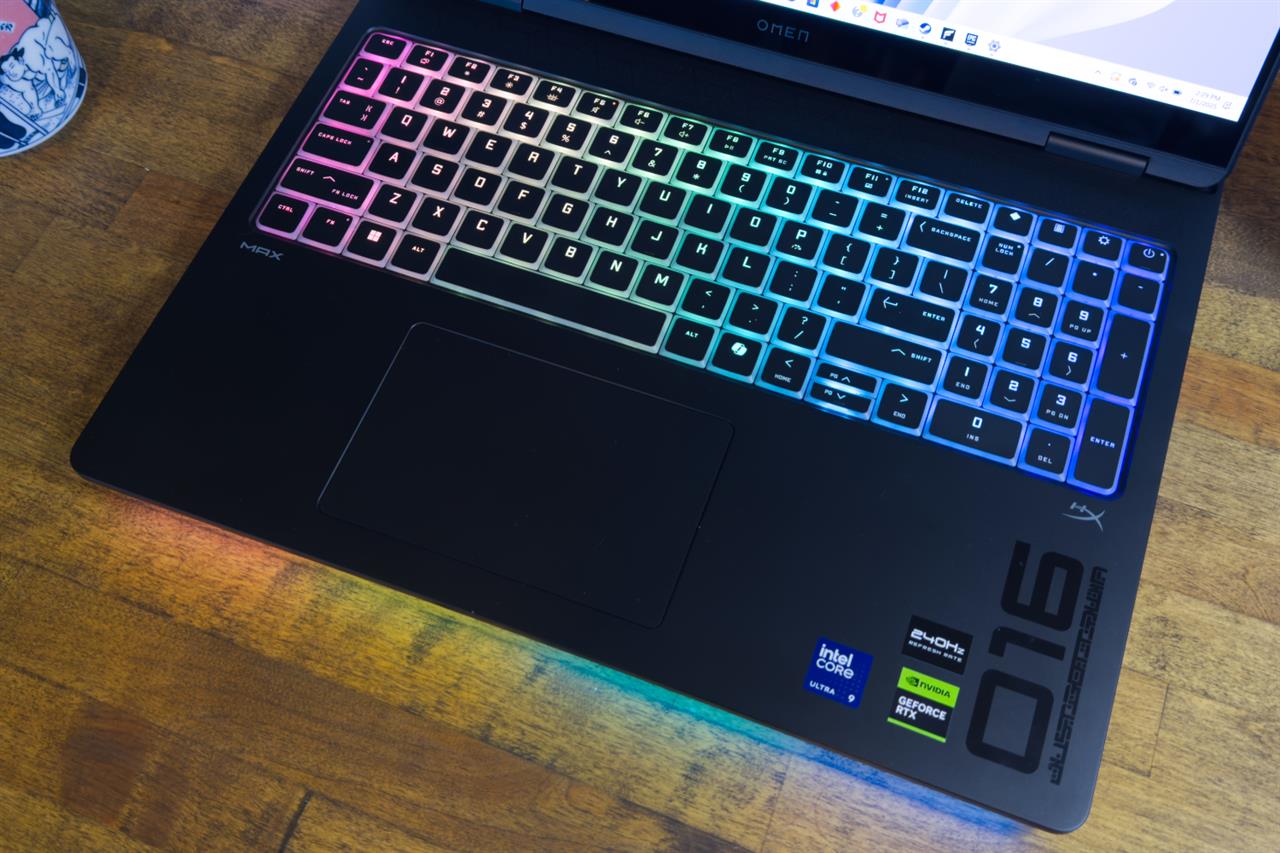
But while the Omen Max 16’s look is mostly plain, there’s one key exception: the keyboard. It’s an RGB-LED keyboard with support for per-key customization, which is typical at this price. However, the key design includes a lot of transparent material, the LEDs are bright, and the colors are vibrant. It looks great.
The HP Omen Max 16 may not aggressively grab your eye, but it feels sturdy, with modest flex across the display lid and keyboard.
It’s functional, too. The Omen Max 16 smartly puts several important ports, including the barrel-plug power adapter, Ethernet, HDMI-out, and a single USB-A port, on the rear of the laptop (though it would’ve been nice to find a Thunderbolt / USB-C port there, too; both are on the laptop’s left flank instead).
I prefer to see ports on the rear of a gaming laptop, as it keeps the cables out of the way when you place the laptop on a desk and hook it up to a monitor.
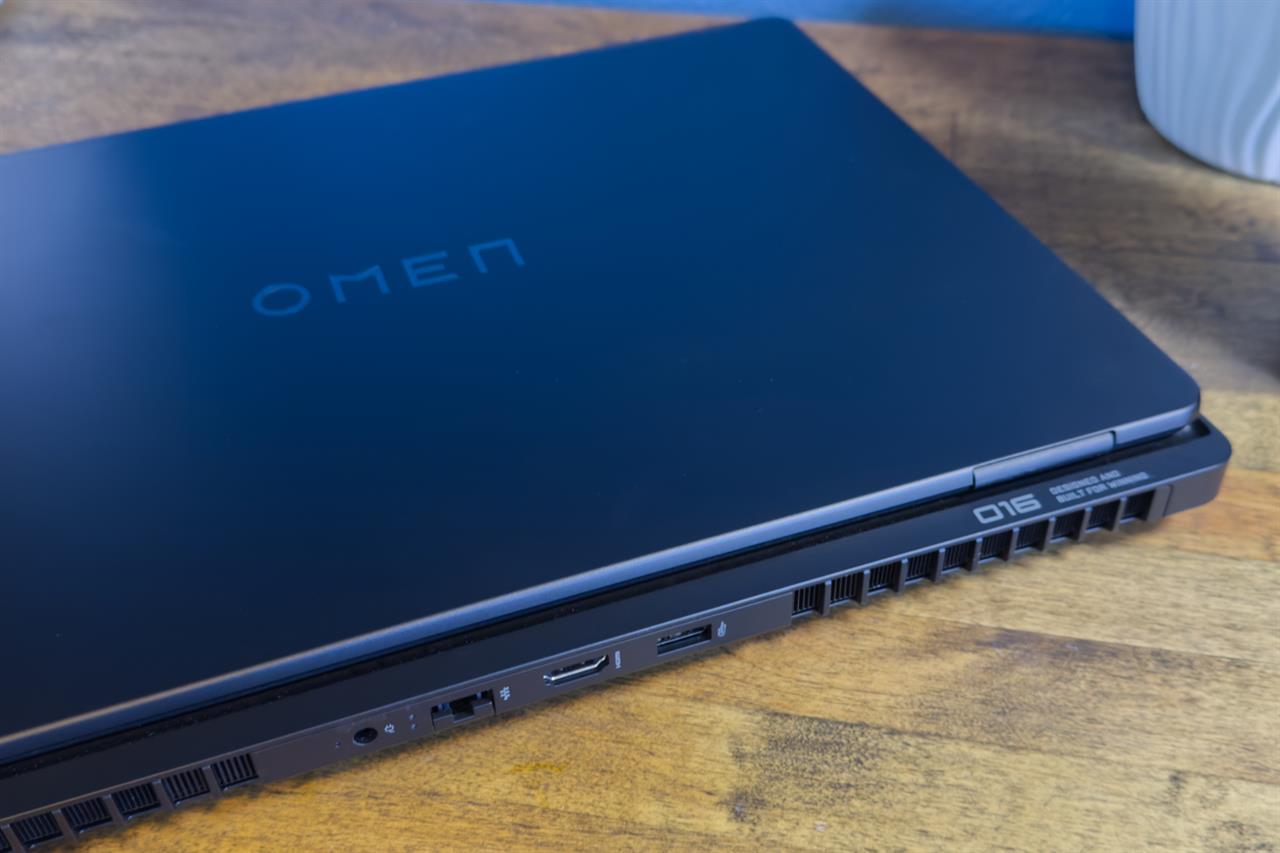
Photo: Matthew Smith
HP also deserves praise for fitting Nvidia’s RTX 5080 in a chassis that’s affordable, yet packable. The Omen Max 16 weighs in at 6.1 pounds and measures just a hair less than an inch thick. That's a tad thinner than similar systems like the MSI Vector 16 and Asus ROG Strix Scar 16.
Display and audio
The HP Omen Max 16 ships with a 16-inch OLED display with a resolution of 2,560 x 1,600 and a 240Hz refresh rate. It’s a bright, vibrant display with decent HDR, excellent contrast, and a wide color gamut. The only downside is the display’s highly reflective glossy coat, but that’s common for laptops with an OLED panel (and usually a worthwhile compromise).
The display’s resolution and refresh rate are a good match for the laptop’s performance, too. Most games can hit 120 frames per second on the Omen Max 16 (with DLSS frame generation turned on), so the display’s 240Hz refresh rate will provide noticeable benefits in motion clarity and smoothness.
On a more subtle note, the Omen Max 16 supports Nvidia G-Sync for smooth frame pacing. It also supports Nvidia Optimus, which means the power-hungry RTX 5080 will switch off and pass graphics to the laptop’s IGP to save power outside of games and other demanding apps. While many gaming laptops support these features, they’re not ubiquitous, and I’m pleased to see HP didn’t skip them in an effort to keep the laptop’s price in check.
The Omen Max 16’s speakers also make a good first impression. They’re loud and have a hint of low-end oomph. However, like most laptops, they can get harsh at high volumes, so I recommend headphones if you want to immerse yourself in a game, movie, or music.
Price and recommendation
In a sea of high-priced gaming laptops that offer similar performance, the HP Omen Max 16 stands out for its smart blend of power and value. While it may not have the most head-turning design, it delivers where it counts, with strong gaming performance and a deep feature set.
Similar configurations can run $3,000 or more, but the Omen Max 16 was $2,799 when I started writing this review, and is currently available for $2,499. A few brands offer less expensive RTX 5080 gaming laptops, but most that slide in under the Omen Max 16's price have just 16GB of RAM.
That makes the HP Omen Max 16 an easy recommendation if you’re looking for an RTX 5080 laptop. The Omen Max 16 offers good performance across the board, avoids major problems, and delivers plenty of frames-per-dollar.
And, hey...isn’t that what most gamers want from a gaming laptop?
More from MC News
- The NVIDIA 50 Series Laptop Buying Guide
- Best 3D Printer Projects for Nintendo Switch 2
- How to Upgrade Your Laptop's RAM and Storage
- How to Build Your Own AI Personal Assistant
- The End is Coming for Windows 10: What You (Still) Need to Know
- Keyboard 101: Intro to Computer Keyboards
- Fix It Yourself: Talking to iFixit on Why Repairable Tech Matters
Matthew S. Smith is a prolific tech journalist, critic, product reviewer, and influencer from Portland, Oregon. Over 16 years covering tech he has reviewed thousands of PC laptops, desktops, monitors, and other consumer gadgets. Matthew also hosts Computer Gaming Yesterday, a YouTube channel dedicated to retro PC gaming, and covers the latest artificial intelligence research for IEEE Spectrum.


